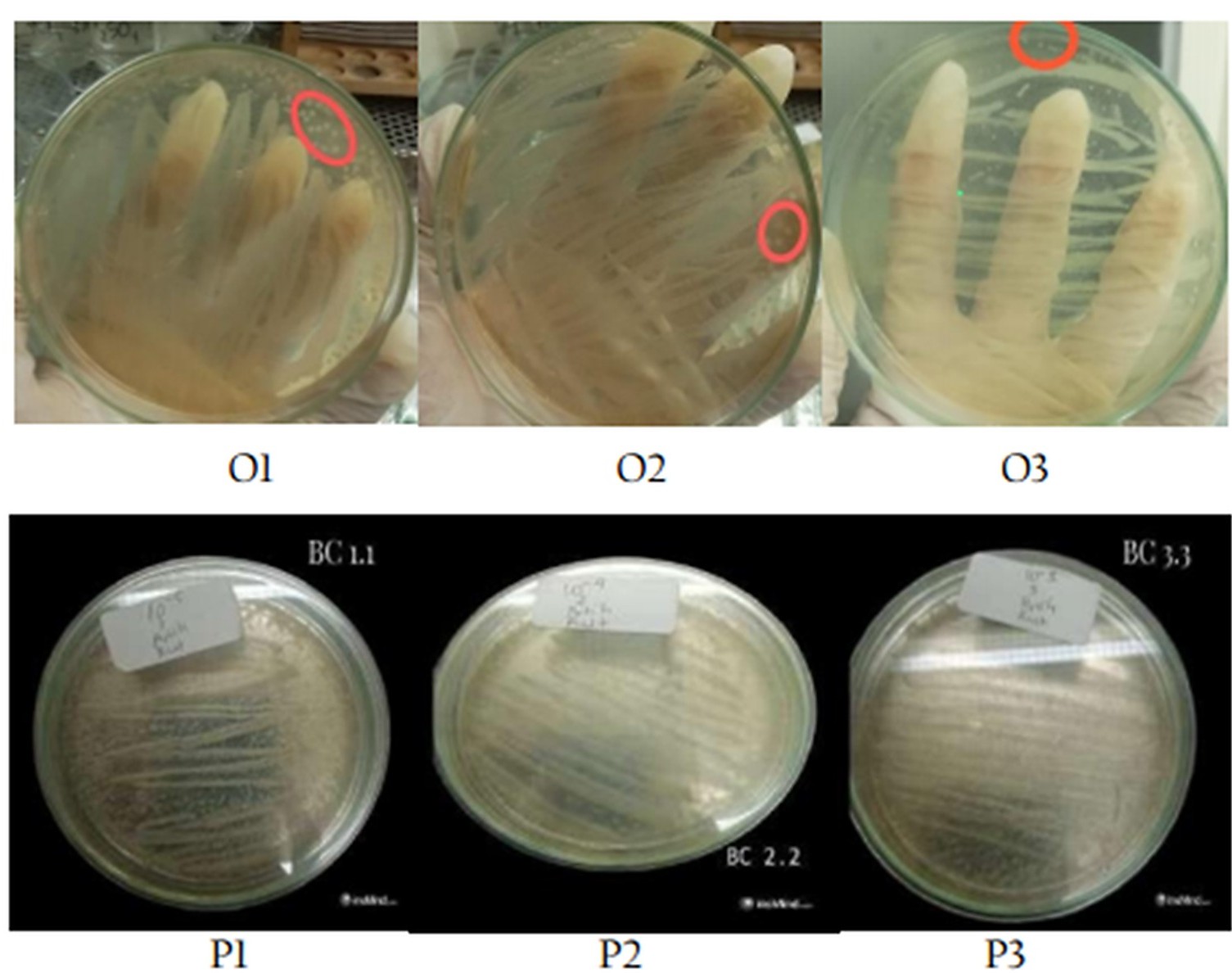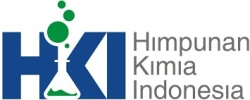Isolation and Identification of Halotolerant Bacteria in Saline Soils from the Coastal Areas of Oebelo White Sand Beach and Pariti Beach
Abstract
A study has been conducted to isolate and identify halotolerant bacteria in saline soils from the coastal areas of Oebelo White Sand Beach and Pariti Beach. The sampling method used was random sampling. During sampling, pH, electrical conductivity (EC), and soil temperature were also measured. Bacterial isolation was performed using a serial dilution technique, resulting in three pure isolates from each beach sand sample. The isolates were cultured on Nutrient Agar (NA) medium and incubated at 37°C for 24 hours. The colonies obtained were small, round, and white. The isolates were then purified using the streak plate method. The halotolerant test was conducted using Tryptic Soy Agar (TSA) medium without added salt. The results showed that the bacterial colonies were halotolerant, as indicated by growth after 24 hours of incubation. Further biochemical tests, including motility, citrate utilization, urease, and sugar hydrolysis, revealed that all isolates from Oebelo White Sand samples showed positive results for all tests, whereas isolates from Pariti Beach exhibited some variations. These findings indicate that the isolates were capable of hydrolyzing urea into ammonia, utilizing citrate as a carbon and energy source, and fermenting sugars present in the medium.
Downloads
References
Ramasamy, K. P., & Mahawar, L. (2023). Coping with salt stress: Interaction of halotolerant bacteria in crop plants: A mini review. Frontiers in Microbiology, 14, 1077561.
Nazhifan, S. F., Dewi, K., & Asih, E. N. N. (2023). Bakteri Halofilik dan halotolerant dari air baku tambak garam Universitas Trunojoyo. Jurnal Pengolahan Hasil Perikanan Indonesia, 26(1), 67–76.
Firdaus, A. M. (2023). Pemberdayaan Masyarakat Pesisir Melalui Budidaya Tanaman Sistem Hidroponik. Ininnawa: Jurnal Pengabdian Masyarakat, 1(2), 238–246.
Reang, L., Bhatt, S., Tomar, R. S., Joshi, K., Padhiyar, S., Vyas, U. M., & Kheni, J. K. (2022). Plant growth-promoting characteristics of halophilic and halotolerant bacteria isolated from coastal regions of Saurashtra, Gujarat. Scientific Reports, 12(1), 4699.
Zamanzadeh-Nasrabadi, S. M., Mohammadiapanah, F., Hosseini-Mazinani, M., & Sarikhan, S. (2023). Salinity stress endurance of plants aided by bacterial genes. Frontiers in Genetics, 14, 1049608.
Scagel, C. F., Lee, J., & Mitchell, J. N. (2019). Salinity from NaCl alters nutrient and polyphenolic composition in basil leaves. Industrial Crops and Products, 127, 119–128.
Rahman, S. S., Siddique, R., & Tabassum, N. (2017). Isolation and identification of halotolerant soil bacteria from the coastal Patenga area. BMC Research Notes, 10, 1–6.
Rohmah, N. S. (2017). Isolasi dan Identifikasi bakteri yang berpotensi sebagai agen bioremediasi timbal (Pb) dari lumpur lapindo. (Doctoral Dissertation, Universitas Islam Negeri Maulana Malik Ibrahim).
Amaliah, P., Mubarik, N. R., & Suryani. (2017). Isolasi dan Seleksi Bakteri Proteolitik Halotoleran dari Inasua dan Karakterisasi Aktivitas Protoasenya. Bogor Agricultural University.
Sabdaningsih, A., & Lunggani, A. T. (2020). Isolasi dan Karakterisasi Morfologi Bakteri Halofilik dari Bledug Kuwu,Kabupaten Grobogan. Bioma: Berkala Ilmiah Biologi, 22(1), 46–52.
Pallavi, Mishra, R. K., Sahu, P. K., Mishra, V., Jamal, H., Varma, A., & Tripathi, S. (2023). Isolation and characterization of halotolerant plant growth-promoting rhizobacteria from the mangrove region of Sundarbans, India, for enhanced crop productivity. Frontiers in Plant Science, 14, 1122347.
Handayani, S. (2018). Isolasi dan Karakterisasi Bakteri dari Tanah pada Lahan Praktek Mahasiswa. Fakultas Biologi Universitas Medan Area.
Rohmah, N. S. (2017). Isolasi dan identifikasi bakteri yang berpotensi sebagai agen bioremediasi timbal (Pb) dari lumpur lapindo. (Doctoral dissertation, Universitas Islam Negeri Maulana Malik Ibrahim).
Nazhifan, S. F., Dewi, K., & Asih, E. N. N. (2023). Bakteri halofilik dan halotoleran dari air baku tambak garam Universitas Trunojoyo Madura. Jurnal Pengolahan Hasil Perikanan Indonesia. 26(1), 67-76.
Fitri, D. A., Asih, E. N. N., Kartika, A. G. D., Agustina, N., Fadholi, B., Dewi, K., & Efendy,
M. (2022). Morphological characteristics of halophilic bacteria in traditional salt production. Journal Of Marine Resources And Coastal Management. 3(1), 1-7.
Romadloni, M. Y., Wibowo, F. A. C., Wahidiah, T., & Pradipta, A. (2024). Isolasi Bakteri Perlarut Fosfat (BPF) pada Hutan Produksi di Kawasan Hutan dengan Tujuan Khusus (KHDTK) Pujon Hill UMM, Kabupaten Malang. Berita Biologi, 23(1), 91-102.
Maryani, M., Monalisa, S. S., & Panjaitan, R. S. (2021). The Effect of Ketapang leaves extracts (Terminalia catappa) in inhibiting the growth of bacteria Edwarsiella tarda on in vitro test. Jurnal Perikanan dan Kelautan, 10(2), 196-208.
Hernández-Canseco, J., Bautista-Cruz, A., Sánchez-Mendoza, S., Aquino-Bolaños, T., & Sánchez-Medina, P. S. (2022). Plant growth-promoting halobacteria and their ability to protect crops from abiotic stress: an eco-friendly alternative for saline soils. Agronomy, 12(4), 804.
Suryani, S., & A’yun, Q. (2022). Isolasi Bakteri Endofit dari Mangrove Sonneratia alba Asal Pondok 2 Pantai Harapan Jaya Muara Gembong, Bekasi. BIO-SAINS: Jurnal Ilmiah Biologi, 1(2), 12-18.
Salam, A. N. (2021). Jumlah dan Morfologi Bakteri Halofilik Dan Halotoleran Pada Telur Asin Komersial di Makassar. Fisheries Research, 140(1), 6.
Savitri, S. D. N. (2006). Isolasi dan karakteristik bakteri halotoleran pada peda ikan kembung (Rastrelliger sp.). Bogor Agricultural University.
Yusra, Y., Azima, F., Novelina, N., & Periadnadi, P. (2014). Isolasi dan identifikasi mikroflora indigenous dalam budu. Agritech, 34(3), 316-321.
Sutiknowati, L. I. (2018). Keragaman Bakteri Pada Perairan Sabang, Provinsi Aceh. Majalah
Ilmiah Biologis Biosfera: A. Scientific Journal, 35(2), 54-62.
Anggraini, R., Aliza, D., & Mellisa, S. (2016). Identifikasi bakteri Aeromonas hydrophila dengan uji mikrobiologi pada ikan lele dumbo (Clarias gariepinus) yang dibudidayakan di Kecamatan Baitussalam Kabupaten Aceh Besar. (Doctoral dissertation, Syiah Kuala University).
Arwin, M., Ijong, F. G., & Tumbol, R. (2016). Characteristics of Aeromonas hydrophila isolated from tilapia (Oreochromis niloticus). Aquatic science & management, 4(2), 52-55.
Lestari, P., Suryadi, Y., Susilowati, D. N., Priyatno, T. P., & Samudra, I. M. (2015). Karakterisasi bakteri penghasil asam indol asetat dan pengaruhnya terhadap vigor benih padi. Berita Biologi, 14(1), 19-28.
Fauziah, S. I., & Ibrahim, M. (2020). Isolasi dan Karakterisasi Bakteri Selulolitik pada Tanah Gambut di Desa Tagagiri Tama Jaya, Kecamatan Pelangiran, Kabupaten Inhil, Riau. LenteraBio: Berkala Ilmiah Biologi, 9(3), 194-203.
Yulianto Ade, P. (2019). Deteksi Fenotipik Escherichia coli Penghasil Extended Spectrum Beta-Lactamases (ESBLS) pada Sampel Makanan di Krian Sidoarjo. Life Science Journal, 8(1), 75-85.
Dewi, K., Asih, E. N. N., Fitri, D. A., & Astutik, S. (2022). Karakterisasi fisiologis isolat bakteri halofilik dari kolam Peminihan tambak garam rakyat di Kabupaten Pamekasan. Juvenil: Jurnal Ilmiah Kelautan dan Perikanan, 3(3), 79-84.
Fallo, G., & Sine, Y. (2016). Isolasi dan uji biokimia bakteri selulolitik asal saluran pencernaan rayap pekerja (Macrotermes spp.). Bio-Edu: Jurnal Pendidikan Biologi, 1(2), 27-29.
Shing, S. (2018). Characterization of Citrate Dehydrogenase from Citrus sinensis.
Marzuki, I. (2019). Aplikasi mikrosimbion spons dalam bioremediasi lingkungan.
Manalu, R. T. M., & Febriani, A. (2021). Isolation and characterization of lactic acid bacteria in fermented sweet corn (Zea mays l) as antibacterial. Bioscience, 5(2), 141-149.
Sari, R. Identifikasi bakteri asam laktat (BAL) penghasil Bakteriosin dari makanan botok ikan tongkol (euthynus affinis c) khas kalimantan barat yang memiliki aktivitas terhadap bakteri patogen. Jurnal Mahasiswa Farmasi Fakultas Kedokteran UNTAN, 4(1).

Copyright (c) 2025 Yosep Lawa, Serlina Utami, Rut Delviana Lede Kore, Yantus A. B. Neolaka, Arvinda Ceniorita Lalang, Jacky Anggara Nenohai, Maria Anastasia Kutu Woa

This work is licensed under a Creative Commons Attribution-ShareAlike 4.0 International License.
 This work is licensed under a Creative Commons Attribution-ShareAlike 4.0 International License. Copyright is retained by the authors, and articles can be freely used and distributed by others.
This work is licensed under a Creative Commons Attribution-ShareAlike 4.0 International License. Copyright is retained by the authors, and articles can be freely used and distributed by others.

 Yosep Lawa(1*)
Yosep Lawa(1*)











